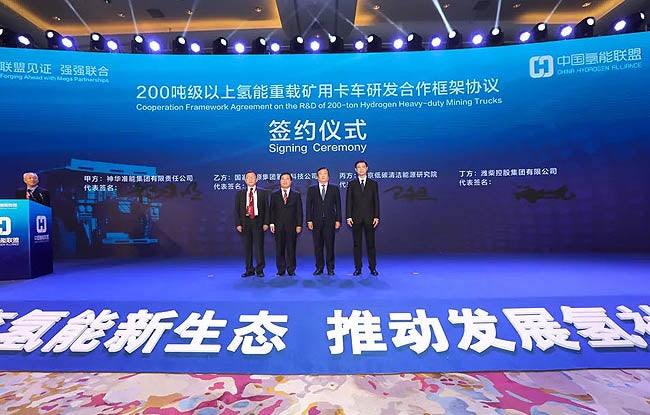
Hydrogen could dominate the future of the world’s transportation. By passing hydrogen and oxygen through a fuel cell, heat and electricity is produced, and the clean, efficient process has generated a lot of attention within the transport sector in recent years. Figures from Global Market Insights suggest that the hydrogen generation market alone could be worth $160bn by 2026, boasting a combined annual growth rate of more than 6%.
While much of this interest is around private electric vehicles or public transport, the mining industry could be set to gain from improvements in hydrogen-powered technology. A 2020 report from Deloitte described many hydrogen fuel cells in the mining industry as at the “prototype” stage, with research and development leading to radical new technologies, with none more famous than Anglo American’s 290-ton hydrogen-powered mining truck .
Yet there is significant investment in hydrogen-powered mining vehicles beyond this, literally, massive example, with international financial agreements in new technology projects in Chile and China painting a very positive outlook for the future of hydrogen fuel cells in mining.
Chile pursues “dual fuel” approach
While Anglo American has made an ambitious move to power its gargantuan truck with hydrogen alone, a Chilean project is targeting a more reliable power system. Alta Ley, a spin-out of governmental economic development organisation CORFO, has partnered with Austrian technology firm Alset to develop what it calls a “dual fuel” system, where hydrogen and diesel are both used to power existing combustion engines.
This system could be a relatively straightforward transition, with no need for new engines to be constructed, and a role remaining for traditional diesel fuels to play. Corfo first announced the project in 2018, and aims to produce a functional mining truck prototype by 2021, the three-year turnaround epitomising the ease with which the developers hope mining companies can transition to the new power source.
The hydrogen-powered trucks also aim to deliver a number of the same environmental benefits as Anglo American’s vehicle, with the reduction in reliance on diesel fuel, however partial, generating significant environmental advantages. Alset predicts that a fuel mix of 70% hydrogen could cut carbon dioxide emissions by around 2,260 tons per year, and noted that hydrogen can be locally produced, divorcing its supply from the geopolitically tense and complex supply of oil around the world.
Despite this potential, it remains to be seen if hydrogen-powered trucks can be truly game-changing for Chile, considering the country’s vast mining infrastructure. In 2019, Chile produced around 5.6 million metric tons of copper, the most in the world, and the country’s greenhouse gas emissions from copper mining alone have increased by around 40% between 2010 and 2018, highlighting the widespread and historically polluting nature of the Chilean copper industry.
China joins the 200-ton hydrogen vehicle race
Not to be outdone by Anglo American and CORFO, state-owned Chinese firm the Weichai Group has partnered with the country’s National Energy Group to deliver its own 200-ton hydrogen truck. The vehicle, which was announced last December, uses a control system developed by CRRC Yongji Electric, which specialises in the development of rail infrastructure and has already worked on a 240-ton electric truck, albeit one not designed for mining work.
The new truck design offers significant improvements in operational efficiency, with such a vehicle saving, on average, 20 tons of fuel per day, equivalent to over 21,000 litres of diesel. This could cut carbon dioxide emissions of each vehicle by around 57 tons per day, delivering significant environmental approvals.
The project also has support from actors across Chinese energy. In addition to government support inherent in the Weichai Group, a report from the International Renewable Energy Agency (IRENA) found that the Ministry of Science and Technology had provided research and development funding for two separate projects aiming to further the country’s research into fuel cell technologies.
However, the same IRENA report found that China may be an unsuitable environment for large-scale hydrogen fuel cell development due to a perceived “competition with growing national energy demand”. Indeed, a 2019 BP report found that China’s average annual energy consumption is set to increase by 1.1% year-on-year, and will account for 22% of the world’s total energy consumption by 2040. While China has invested dramatically in its own energy production, it will only account for 18% of global energy generation in 2040, creating an energy deficiency that could see new energy projects, such as large-scale hydrogen-powered mining vehicles, shelved in favour of policies and programmes to address this deficit.
Mitsui’s $25m hydrogen investment
Many of these new technological developments would be impossible without significant financial support, and Japanese trading giant Mitsui has staked a claim in the hydrogen-powered mining sector. The firm has invested $25m into FirstElement Fuel (FEF), the largest developer of hydrogen fuel stations in California, and the agreement brings together one of the sector’s brightest startups and most well-established mining financiers.
The deal follows a year of collaboration between the companies, and is Mitsui’s latest move in the hydrogen industry. The company has participated in the world’s first international hydrogen supply chain demonstration project, which will see 210 tons of hydrogen supplied from a gas liquefaction plant in Brunei, enough to power 40,000 vehicles. Mitsui has also made investments into fuel cells, power storage, transportation, and backup power solutions in the hydrogen sector, as it aims to deliver not just technological innovation, but a robust supply chain for the future of the industry.
Yet it is unclear whether this investment will see a direct impact on the company’s mining portfolio, and mining in general. Mitsui energy business chief operating officer Masaharu Okubo told the Hydrogen Council last year that the FEF deal will enable the investor to “gain access to one of the most advanced markets of hydrogen mobility, and take a leading role in an initiative to reduce carbon emissions in the mobility sector.” These are important developments, but ones that do not necessarily lead to the kind of tangible changes in mining operations and equipment backed by Anglo American and CORFO.
Miners unite on hydrogen innovation
Collaboration is often a hallmark of new innovations in the mining sector, and hydrogen power is no different. Earlier this year, Fortescue, Hatch, BHP, and Anglo American formed a consortium to investigate the use of hydrogen to decarbonise their operations through ‘green hydrogen’, which is produced through the same electrolytic processes as other hydrogen, albeit powered by renewable power sources.
Much like Mitsui’s holistic investment, this consortium will focus on delivering a sustainable and financially viable supply chain for the hydrogen sector, and will contribute to research and development and the deployment of green hydrogen pilot studies. While the group has not announced plans for mining vehicles in particular, with the work that Fortescue, BHP, and especially Anglo American do in mining and new fuel technologies, there is hope that this cross-company collective will be able to deliver results for the nascent technology.
The timing could not be better, with a report from McKinsey and the Hydrogen Council claiming that the production costs of hydrogen could fall by 50% by 2030, and that renewable hydrogen alone could meet 15% of the world’s energy needs within the decade. The report also notes that hydrogen could be the cheapest source of any fuel in nine industries, including transport, so this consortium of miners could be a driving force in bringing about change in the mining vehicle sector in particular.




